Inflatable boats have gained immense popularity for their versatility, affordability, and ease of use. Whether you’re looking for a boat for leisure activities, fishing, or emergency situations, inflatable boats offer a practical solution. This comprehensive guide delves into everything you need to know about inflatable boats, from their types and features to maintenance tips and popular brands. We’ve also addressed some common questions people search for on Google and YouTube to ensure you have all the information you need.
What is an Inflatable Boat?
An inflatable boat is a type of watercraft that relies on inflated chambers to provide buoyancy and structure. Unlike traditional boats with rigid hulls, inflatable boats use air-filled tubes to stay afloat. This design allows them to be deflated and stored compactly when not in use, making them ideal for recreational use and storage in small spaces.
Types of Inflatable Boats
There are several varieties of inflatable boats, each intended for a particular purpose.. Here are the most common types:
Inflatable Dinghies: Inflatable dinghies are small, lightweight boats typically used as tenders for larger vessels or for short trips on calm waters. They are easy to handle, transport, and store, making them a popular choice for boaters.
Inflatable Kayaks: These are designed for single or tandem paddling and are ideal for recreational paddling on rivers, lakes, and coastal waters. Inflatable kayaks offer the benefit of portability and ease of storage compared to traditional hard-shell kayaks.
Inflatable Rafts: Inflatable rafts are larger and more robust, suitable for white-water rafting and other adventurous water sports. They are built to handle rough waters and often come with reinforced materials and multiple air chambers for safety.
Key Features to Consider
When choosing an inflatable boat, several features can influence your decision. Here’s what to consider:
Material: Most inflatable boats are made from PVC (polyvinyl chloride) or Hypalon (a type of synthetic rubber). PVC is more affordable and lighter, while Hypalon is more durable and resistant to UV rays and chemicals. The choice of material affects the boat’s lifespan and performance.
Size and Capacity: Consider the number of passengers and the type of activities you plan to do. Boats come in various sizes, from single-person kayaks to larger pontoons and RIBs that can accommodate several people.
Air Chambers: Multiple air chambers provide redundancy in case one chamber gets damaged. Boats with separate chambers are safer as they can still stay afloat even if one chamber is compromised.
Portability and Storage: One of the main advantages of inflatable boats is their portability. They can be deflated and stored in a compact form. Look for features like carrying handles, storage bags, and quick inflation/deflation mechanisms.
Benefits of Inflatable Boats
Portability: Inflatable boats are easy to transport and store, making them ideal for those with limited space or for taking on trips.
Affordability: Compared to rigid boats, inflatable boats are generally more affordable. They offer a cost-effective solution for those who want a boat without a significant financial investment.
Ease of Use: Inflatable boats are user-friendly and require minimal setup. Most can be inflated and ready for use within minutes.
Safety: Safety is a top priority in the design of contemporary inflatable boats. Features such as multiple air chambers and reinforced materials ensure that they are safe to use in various conditions.
Maintenance and Care
Proper maintenance extends the lifespan of your inflatable boat. Here are some tips:
Cleaning: After every usage, especially if you’ve been in saltwater, rinse the boat with fresh water. Use mild soap and a soft brush to remove dirt and debris.
Drying: Allow the boat to dry completely before deflating and storing it. This prevents mold and mildew from forming.
Storage: Store the boat in a cool, dry place away from direct sunlight. Avoid storing it in places where it can be punctured or damaged.
Inspection: Regularly inspect the boat for any signs of wear or damage. Check the seams, valves, and air chambers for leaks or punctures. Most inflatable boats come with a repair kit for minor fixes.
Popular Brands and Models
Several brands are renowned for their quality inflatable boats. Here are a few worth considering:
Intex: Intex is known for its affordable and reliable inflatable boats, including dinghies, kayaks, and rafts. They offer a range of options for recreational use.
Sea Eagle: Sea Eagle produces high-quality inflatable boats suitable for various activities, from fishing to white-water rafting. Their boats are known for durability and performance.
Zodiac: Zodiac is a leading brand in the RIB market. Their inflatable boats are used by professionals and are known for their robustness and reliability.
Advanced Elements: Advanced Elements specializes in inflatable kayaks and canoes. Their goods are renowned for their superior performance and creative designs.
FAQs
Can inflatable boats be used in the ocean?
Yes, inflatable boats can be used in the ocean, especially those designed for rough waters like RIBs. However, it’s important to choose a boat suitable for ocean conditions and to follow safety guidelines.
How do you repair a punctured inflatable boat?
Most inflatable boats come with a repair kit that includes patches and adhesive. Clean and dry the damaged area, apply the patch, and let it cure according to the manufacturer’s instructions.
Are inflatable boats safe?
Modern inflatable boats are designed with safety features such as multiple air chambers and durable materials. However, always follow safety guidelines and ensure the boat is properly maintained.
Conclusion
Inflatable boats offer a versatile and practical solution for a wide range of boating activities. Whether you’re a recreational boater, angler, or adventurer, there’s an inflatable boat to suit your needs. By understanding the different types, features, and maintenance tips, you can choose the right boat for your adventures and enjoy years of fun on the water.
To read more, Click Here .

